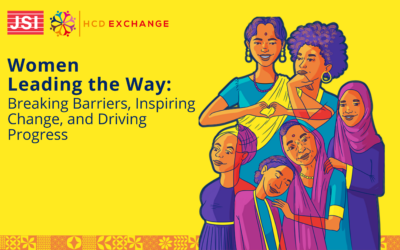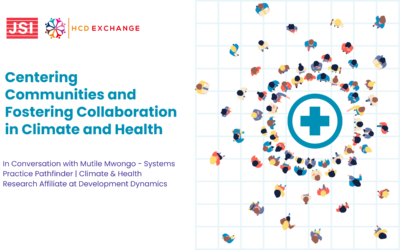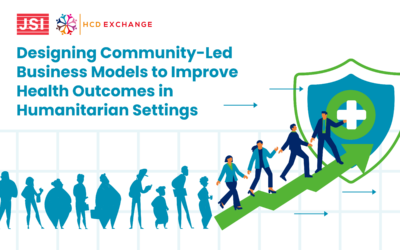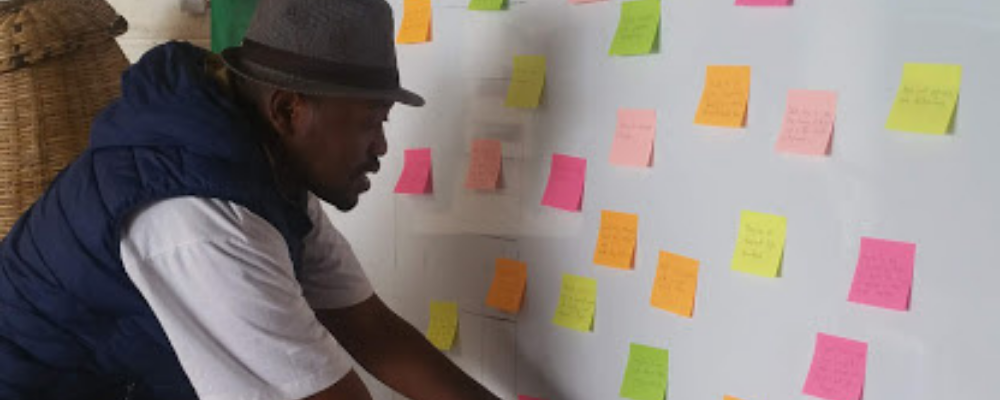
David is a 2021 fellow with PS Kenya/Adolescents360. He is a multidisciplinary designer who has diverse experience working as a freelancer and within startups. David believes in gaining experience across different domains because he believes that there is no direct path to opportunity. David credits his varied work experience for helping him become an agile, creative free thinker who can move between nonlinear careers and add value no matter the environment or situation.
David’s work as a designer has ranged from working with entrepreneurs and start-ups to facilitating market access for farmers. He is excited to be recognised as a talented and creative leader through the HCDExchange Fellowship, and is ready to apply his skills in human-centered design to solve problems for the HCD+ASRH field.
Can you tell me a little bit about yourself and your work?
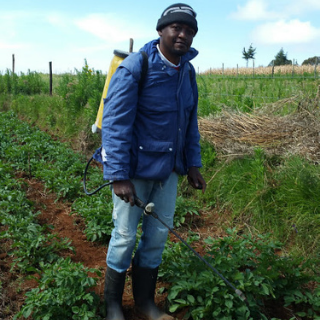
I am David Mireri and I am a product designer by profession. I have a bachelor’s degree with a specialisation in corporate finance and behavioral economics. It is the behavioural economics aspect of my interest that has really carved the path to our engagement today. I am also a certified user experience designer and a professional Co-creator in Enterprise Design Thinking certified by IBM. Currently, alongside the Fellowship, I am pursuing a course in design and implementation of CIC’s, which is Community Inclusion Currencies. I have worked in different organisations in corporate finance. I have worked with the bank, which is currently called the Absa group as a CRM – Customer Relationship Manager. In terms of my design experience I have worked with organisations such as The Bhub as a user experience design developing applications. I have also worked with Laibon Brothers LLC, which is an organisation that deals with the Internet of Things. I was developing their website so that they could increase their outreach to potential customers. In relation to Enterprise Product design, I have also worked with an Agribusiness startup whose objective was to reach out to farmers and give them access to the market. That is where I developed most of my interaction with the youth and was also able to implement my learnings from behavioural economics. That is me professionally.
Personally, I have been on a quest to discover new values and interests, and see if they can be airlifted and put into completely new sectors. That is why I attach so much value in the things that I’ve learned, and also the things that I’m able to apply from the knowledge that I’ve acquired. In the 21st century information is very flexible, and knowledge is not static. I believe that the value that I bring is in my ability to acquire new knowledge and translate it into a solution and consequently implement the solution that I come up with.
Besides that I am passionate about farming. Farming in my opinion actually covers all the aspects of the things that I have learned – managing people, iterating as you’re going along because in crop husbandry sometimes you encounter surprises, like pesticides that you’ve never seen before. You learn and iterate as you go in farming and that is what I love. I’m very passionate about it, and currently doing mostly potato farming and it is in the planting season.
In farming my values of acquiring new knowledge and applying it are put to use because you have to be really engaging in it. I always say that the best fertiliser for a plant is the farmer’s shadow. That shows the relationship you have to have with your plants so you can nurture them accordingly, understand them properly, and really have a good output from your farm. This is also applicable to our profession as human centered designers. We have to put our users at the center of our interventions. You have to understand the target audience and really bring out their perspective so that whenever you come up with a solution, it really speaks to what they are trying to achieve. When you are able to really connect is when you’re able to deliver a solution that works, and is sustainable because it is embraced as their own. I relate the plant and the user in that way.
What attracted you to the HCDExchange fellowship?
Maybe I can take you back to when I just completed some of my design specific courses. Soon after, I realised that this kind of profession cannot be done as a lone ranger, and so I was looking for a society of designers where we could share experiences and learnings. That is what led me to being a member of HCDExchange. As I was shopping around for a society, I came across this community of practice.
More specifically, I was attracted to the design fellowship due to my desire to make a change within society, and knowing that at the end of the day I could have a positive impact in someone’s life. I really like working with young people because the conditioning of young people is not as intense as that of people who, for instance, have been in their careers for a long time. There is a way that they are naturally attuned to the new world, and that is what I really resonate with. I saw this as an opportunity to unlock the intergenerational engagement between people who come in as interventionists and the young people. It is a way to bring me closer to providing meaning to adolescents, and at the same time delivering a unique and rich value proposition.
Can you tell me about the organisation that you are working with and the project you are working on?
I am working for an organisation called PS Kenya, a member of PSI, under the A360 adolescent programme being implemented in Kenya, Tanzania, Ethiopia and Nigeria. Key partners for this programme include the Ministry of Health, Society for Family Health Nigeria, IDEO.org, ITAD and BRAC. The initiative is funded by Bill and Melinda Gates Foundation and the Children’s Investment Fund Foundation. A360 is based on evidence of the practices that have been accumulated for adolescent girls and how they uptake modern contraception because there is a gap on how to actualise this uptake of modern contraception, and the objective is to scale it in a way that it can be sustainable and can be taken up by public health within a country. So A360 intervenes to bring in a different approach that may change the narrative from the way that people have been approaching this particular intervention. A360 tries to deliver a youth powered research intervention through meaningful youth engagement. By meaningful youth engagement, I mean that the design process is in partnership with girls not just as subjects but as co-partners and experts of their unique cultural, religious, and societal experiences that shape how the girls themselves and their influencers view contraceptives. A360 has been implemented across Tanzania, Nigeria, and Ethiopia starting in 2016, and is now expanding its work to Kenya in this next phase of the programme.
What are you currently working on at A360 and where are you in that process?

I joined when the team had already completed the design protocol, where they were assisted by IDEO, which is part of the consortium. I started by assisting the team in preparing for the insight gathering phase. In the last month we have been able to successfully carry out the insights gathering phase which was conducted through focus group discussions with adolescent girls in both rural and urban Migori. Currently we are in the process of doing data synthesis from the insights that we obtained. My role as a human-centered designer has been big in trying to assist with uploading and synthesising the data. In the Covid-19 scenario we are in a situation whereby we are not able to do physical workshops. We are doing virtual workshops and uploading all the data that we obtained from the field on Miro, a software that I find quite helpful for collaboration and brainstorming during data synthesis workshops.
The project is currently trying to have a clearer view on who we are targeting, what is the actual persona of the girls that we are targeting and detailing out aspects that affect that persona. For example these could include the people girls normally interact with, the information which they obtain through interactions, current cultural aspects that affect their decision making, whether they are very connected to their cultural practices or a bit detached, and how that affects their decision making. We are trying to understand their influencers – their parents, their teachers, the religious leaders and how they affect the behaviour of girls, and how that can also impact their decision making in how they are approaching SRH matters. These are the data points we are trying to build out, so that once we understand this persona we can go back to the field and interact with them better, and see how our intervention works and how they view it. It sounds like they are on the receiving end of this process by the way I have spoken but we work with them on a daily basis – the girls are part of the workshops and the data synthesis. Their voice is central to our learning. They tell us where we could be going wrong, and how we can improve.
From the synthesis phase we will move to prototyping. The whole process includes five stages – the planning, synthesis, prototyping, piloting, and then launching the intervention before we hand it over to the county governments so that we can ensure that it is run in a sustainable manner.
Speaking about the insights phase, can you take us through your learnings and your process?
So to begin I want to acknowledge that we weren’t going in with a completely new intervention. The planning phase had resulted in articulating the best way to approach this as something we termed prototyping forward. The A360’s programme is not piloting in Kenya – it has been done in Ethiopia, Nigeria and Tanzania. We obtained learnings from those three countries and put them in the form of concept cards. The concept cards highlight the ideas which the A360 teams had obtained from the other three countries.
To give you an idea, a few of the core ideas that the concept cards were built on are:
- SRH topics are not easy to talk about because of the cultural orientation of young girls in some of these regions, and we knew that they were interested in being economically empowered so the concept tried to see how economic empowerment interventions might become a gateway to talk about SRH and contraception.
- Spice talks is a concept whereby young girls are given a platform where they can have discussions amongst themselves and really connect with each other. This would also become a space where SRH topics and contraception could be introduced.
- Another concept centred around mentorship. We heard alot about the girls’ relationship with their mothers and wanted to see how mothers can play a role in educating these young girls since they already have a close connection with them. This concept wanted to leverage the trust between the young girl and the mother, and support the mother to connect with her girls. Through this we hoped to bring in the aspect of SRH so that girls might understand it better and integrate it into her own life.
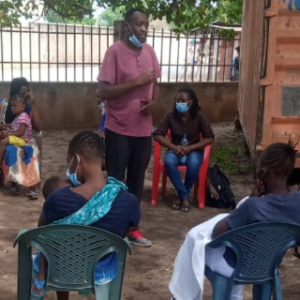
We did a first round of data synthesis from all the concept cards. We tried to narrow down and decide what we can present to the girls, so that as we are talking to them in the initial phases, we might get a better understanding of what actually resonates with them.
There was a dilemma around whether to opt for one on one interviews or focus group discussions with the girls. We finally opted for focus group discussions, mainly because of the challenges we are facing in the current COVID situation whereby it is not easy to move around and obtain the number of people that we really wanted to target. We connected with the local mobilisers within the communities to reach out to the girls and then invited them to a particular location, where we were adhering to COVID protocols of social distancing. We then had a discussion around the concept cards we had created. We had a conversation about the socio-cultural background, education levels, access to network, communication and gadgets, access to health facilities, and many other aspects which covered a general understanding of how and with whom girls interact. We then presented the concept cards to them to try and understand how they feel about them, what they would like, what their suggestions were on how it could be improved.
At the end of the day we would do what we call downloading sessions, whereby we have an informal discussion of what went well during the day and how we could have engaged better so that we go into the discussion the next day better prepared.
What were some of the challenges that you faced in gathering and generating insights?
So one of the challenges that we actually faced in our approach is that most of the girls that we interviewed, we came to realise are members of youth organisations that expose them to ASRH. This resulted in us getting answers that seemed as if they were based on information that the girls had been made aware of through ASRH related intervening. We were not getting a clear picture of what was really going on.
There was also a disconnection between the initial discussion which we had and the more informal discussion during the downloading sessions. For example when we asked the girls who is your biggest influencer or role model most of them would mention their mother. But when we had the downloading session, some of them would mention the role models being successful ladies in the community. Some of these successful ladies in the community are people who are linked to sponsors. The downloading session discussions were good because it gave us the other more organic perspective.
Another challenge was the process of doing data synthesis post returning to our headquarters since we still had to do virtual workshops. I was holding my focus group discussion in Migori. Other team members were holding their discussion in Kilifi, Nairobi, Kajiado and Homabay. A few team members had a challenge when it came to doing the virtual data uploading and synthesis because some had to use Miro for the first time. Finally I took it upon myself to bring them up to speed so that we could make contributions with ease during the virtual workshops. I did some orientation sessions and training on Miro with the team before we moved forward.
How does A360’s process and programme integrate young people?
A360 has always tried to make sure that young girls are the center of this whole process. Girls were involved from the early stages when we were developing the design protocol. For example they helped us in outlining how to approach the influencers. We took their input on who the influencers were and how they might be approached, so that when we design a protocol on how to get information from the influencers, we know who to approach and how to approach them, and we stay within the scope that is defined by the girls.
Young girls were also involved in the insight gathering phase. The community mobilisers that we reached out to are not adults, they are young people who can mobilise their own peers. We can ensure the right target audience in this way. The moderators who are facilitating the FGDs are also young girls themselves. We just train them on how to moderate the discussions, and then they take over. They do their own discussions and present the concept cards. This worked really well because they could actually connect with the participants. They had a very natural way of communicating with the girls in the FGD in ways that they could really understand.
Another aspect of youth integration is sponsor users – referred to as Young Innovation Champions. These are young people who are chosen from the target group to become part of the design process, and be present consistently. They are part of our design process, they attend workshops which we are doing, they are part of Miro board discussions, and they are with us through the whole process to help us course correct if we deviate.
How do you think this form of integrating young girls into the design process has worked for the programme?
I think that it has been very fruitful. We have been able to integrate young girls who we wanted to target specifically. We have seen a change in some of the data we were using to construct the persona because of their contributions. At the beginning of the process, when the girls weren’t there, we had created what I will call a ‘proto-persona’. When the girls came in we had to change a lot of things about this persona to make it more relatable to them based on what they said. That was a very crucial part of the process. If we had gotten the persona wrong we would have gone ahead to develop a product that may not have been as useful to adolescent girls.
What are some of the tools that you have used in your work?
For the virtual workshops Miro has played a big role because it gives us a space to collaborate and work together. Zoom has helped us with bringing the group together, and we used Microsoft teams for internal meetings. We used Adobe XD to design the concept cards. Those are the four major tools we have used in the process.
In the design process has the project used any measurement and evaluation mechanism at different stages?
This particular task is done by a division in the PS Kenya/PSI team that specialises in measurement and evaluation and as part of the consortium ITAD is collaborating with them to integrate measurement and evaluation into the process. So far there has been a bit of a struggle in establishing this particular matrix which we can use to measure. The plan is that before we go back to do further research these metrics will be completed and integrated into our process, so that we can ensure that we are meeting the objectives. These objectives will help provide a benchmark that we can correlate with as we move forward.
As you reflect on your own practice, How would you say you have changed as a human-centered designer through the course of this Fellowship and your work with A360?
I have to say that there has been a steep learning curve in some aspects of the A360 process. I had this familiarity with the design process being conducted a certain way. So far in the HCD process that I have been involved with before A360, there is this concave-convex approach whereby you start by diverging your ideas, and then you converge at some point as you’re heading towards the prototyping phase. Now coming back to the A360 project – after uploading our insights from the field I was anticipating to converge into concepts or solutions. Instead the team that I am working with along with guidance from IDEO actually decided that we had to blow out the process again, thereby diverging even more. I have to say, that one caught me by surprise but it was very critical as I came to realise later. It allowed us to really explore and find solutions that were not conventional.
What has been a moment of success during the Fellowship?
It really boosted my morale when the A360 team acknowledged and appreciated my work. I got wind of an email thread where they had mentioned and if I might quote – “we have really been extremely grateful for David’s contribution to the design process. And we are happy to hear he is also finding it a rewarding experience. This design process is a heavy lift. And David has made our digital download board in Miro that we are using for the design process incredibly clean and clear. He is a great asset to the team.” When I saw this I felt amazing. Sometimes you cannot pinpoint how your contribution is being noted. I am thankful.
What other ways do you feel that you have added value in?
Alongside adding value to the design process there are some templates which I tried to introduce to the team to document the process so that people can refer back to everything that has happened as we move forward, and also be able to understand how to do that process if they were to do it again. So even if we were to hand over this process to PSI, they can just look back at the process and replicate or repeat it.
Is there any particular aspect of the Fellowship that you have enjoyed the most?
The greatest thing about the fellowship is the aspect of community. It is really what I was looking for and I can see that it is there. The bond that I share with the other fellows who are working in other organisations – the way we interact, the way we share ideas, the way we build upon each other’s ideas – I find that very useful! Whenever I struggle, whenever I’m looking for ideas, or even when I want inspiration on how I conduct my insight gathering, I tend to go back to the team, and we have a discussion on how they did something in their work, and how they think it can be done better. This helps me have better suggestions as a designer, and more confidence to voice them to my organisation.
I also liked the fact that some part of the selection panel was people who are designers themselves. In some interviews which I have experienced previously you just find an HR manager and a programme manager but they don’t always understand what design is. Having a human centered designer in the recruitment process is useful because when I mentioned some HCD methods or activities that I carried out in previous research they could relate to it. Sometimes people who do not do HCD don’t understand what you’re talking about.
Learn More:
- Twitter: @rhinnovate
- LinkedIn: https://www.linkedin.com/in/david-mireri/
- Personal website: https://davidmireri.wixsite.com/ux-design
- Organisational website: https://a360learninghub.org/
Copyright
This story is copyright [David Mireri] and published on the HCDExchange website under a Creative Commons Attribution 4.0 International license.
This interview was conducted by Rimjhim Surana, HCD Specialist, HCDExchange.

